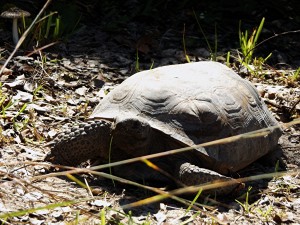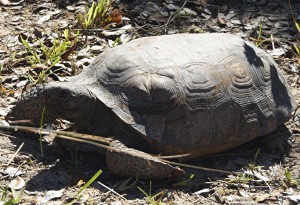These are two pictures of a Gopher Tortoise (Gopherus polyphemus) that I saw in the Hugh Taylor Birch State Park in Fort Lauderdale, FL. I was staying at the Sonesta Hotel across the street for a wedding there and got a few hours to pop across the street and get my nature fix. Luckily I was staying at that particular hotel because this Park is one of the only places that around Fort Lauderdale that is not covered in concrete. Even the beaches are not very “natural” because the Highway A1A is literally 10 ft away and they actually sweep the beach with tractors each morning (which I found disturbing since they had signs posted everywhere about sea turtle conservation, and these tractors were rolling over the beach area where these nests would be). Despite this, Fort Lauderdale is a very nice place to visit, I had a great time there and recommend taking the water taxi up and down the Intercoastal Waterway and see all the mansions and super-yachts. None the less, I got to head across to the park and one of the first things I saw was this gopher tortoise close to the path and got a good picture of him. The park is really cool, being in between the beach and the Intercoastal Waterway it houses a large freshwater lake and mangrove swamp habitats which are great places to view wildlife. I wish I could have spent more time exploring this park.
The Gopher Tortoise gets its name because it does burrow into the ground and uses that burrow as a home and protection from the weather and predators. They live in the Southeast US with most of their population now limited to Florida. They feed mostly on vegetation, but have been known to take small insects and munch on dead animals. They are rarely seen drinking and it is thought that they get most of their water from the food they eat. They lay eggs in the small holes they dig close to their burrows, they lay 4-7 eggs which incubate for 80-110 days. The sex of the eggs is determined the temperature during incubation. If the temperature is below 30 degrees C (86 degrees F) then the sex is male, if the temperature is above 30 degrees C (86 degrees F) then the sex is female. They live to be about 40 years old in the wild, and have been know to live up to 70-75 years in captivity. It takes them 10-15 yrs to reach sexual maturity, which is about the same as humans (a very long time).
These Gopher Tortoise is classified as Threatened as its conservation status. Many studies done on them in their ranges show they are on a steep decline. Here are the top threats to the Gopher Tortoise:
- Habitat loss to human development
- Habitat loss through poor supervision
- Human desire to use as pet or meat
- Relocation causing population disruption
- Disease due to relocation
- Traffic mortality
- Preyed upon by invasive species (raccoon, fire ants, wild dogs, armadillos to name a few)
The sad thing about these threats are that every one of them is directly caused by humans. Without humans messing with their habitats these tortoises would thrive. One important facts is the holes that these turtles burrow out each year are then used as for shelter by approximately 250 other species. In areas where these tortoises have declined so have those other species (some of these include burrowing owls, eastern indigo snake, and gopher frogs). Because of this fact, they are known as a “Keystone Species.” This means that it is a species that other species in the ecosystem largely depend upon, and if this species is removed it would vastly alter the ecosystem as a whole.
One prime example of the ways in which the Gopher Tortoises habitats have changed is the destruction of Longleaf Pine forests. The Longleaf Pine (Pinus palustris) used to grow in large savannas reaching from the coast for about 100 miles inland, and stretched from North Carolina to Texas. These forests are the main habitat for many organisms (many of which are now threatened or endangered). One of these organisms is the Gopher Tortoise. The Longleaf pine forests have declined 96% since Europeans have arrived in North America. There are many conservation groups trying to save this nearly extinct ecosystem. This dying ecosystem is due to humans logging the trees and using the sap (which is distilled into turpentine or tar) for use on ships. The drop in this forest habitat has been estimated to have dropped the overall habitat of the Gopher Tortoise around 80%. Because the Gopher Tortoise takes so long to reach maturity, they do not adapt to changes as fast as some other organism do, which makes them more vulnerable to extinction. If something is not done to protect these awesome animals they will be erased from the planet, and once they go they may take some other organisms with them. There will be one thing to blame for the extinction of these animals, and that will be humans (the ultimate invasive species).
For more information on the Gopher Tortoise and some ways we are trying to save them click here



